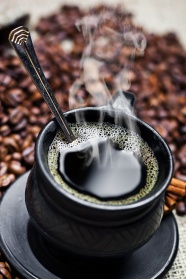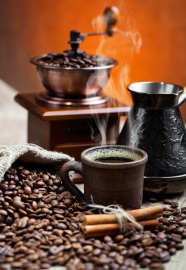Boutique coffee Ethiopian coffee raw bean specification coffee bean introduction coffee bean price coffee bean
The birthplace of coffee-Ethiopia.
The coffee tree originated in Ethiopia, where it was originally a wild plant, and the name "coffee" comes from the Ethiopian town of Kaffa. In fact, many coffee trees in Ethiopia are still wild plants, and the coffee grown on this coffee tree is full of particles and slightly fragrant. Humans may have known how to cultivate coffee trees as early as the ninth century, but who, how, and why remains a mystery. Local Ethiopian legend says coffee began as something monks used to keep their heads clear for evening prayers.
Today, Ethiopia is an important coffee producer, with approximately 12 million people engaged in coffee production, and is Africa's leading exporter of Arabica coffee beans. The quality of coffee here is excellent and worth looking for.
coffee trees
coffee trees
Ethiopia has a variety of coffee cultivation methods: from wild coffee groves and semi-developed plots, to small plots of traditional farming, to modern plantations. About 50 percent of coffee is grown at altitudes of more than 1500 meters.
Harrar coffee is the highest coffee grown in Ethiopia. Hara coffee can be divided into long coffee beans and short coffee beans, of which long coffee beans are the most popular. It has a soft taste, with a wild aroma, and slightly sour, after drinking unforgettable. Djimmah coffee grows wild at more than 1200 metres above sea level and is sold under two brands, Limu and Babeka. Other coffee names include Sidamo coffee from Central, sold under the brand name Yirgachaffe, and coffee with distinctive flavors from Lekempti, where the beans are not pleasant in appearance but taste good.
The rarest Ethiopian coffee beans on the market are Irga Chafee beans, which are exported to Japan and Europe but rarely seen in the United States. This is because Dallmeyer, a German coffee roaster owned by Nestlé, has established close ties with the growers of Ilgachafi coffee, thus obtaining the largest single supply of the beans.
Ethiopian coffee flavor is difficult to describe, it is neither strong, sour nor very obvious. Therefore, it is not suitable for deep baking, otherwise it will easily lose its characteristics.
When it comes to specialty, Ethiopian coffee is somewhat similar to the famous mocha coffee. Of course, quality Ethiopian coffee can be compared to the best coffee from around the world, including its considerable price.
Ethiopia has the highest domestic consumption of coffee in Africa. In the countryside, it is often served with a herb called Health of Adam: fresh coffee beans are roasted and mashed with vanilla, then the mixture is brewed and drunk in small cups, often served with pancakes to bring out the sweet pepper flavor in the pancakes.
The coffee industry is managed by the Ethiopian Coffee Marketing Corporation (ECMC), which controls 90% of the export market. There is a risk that control of Ethiopian coffee companies will soon be relaxed and greater local power will be gained, a move that will benefit the coffee industry as a whole, especially individual traders. Ethiopian coffee is sold at daily auctions and is mostly exported to Germany, the United States, France and Japan.

Important Notice :
前街咖啡 FrontStreet Coffee has moved to new addredd:
FrontStreet Coffee Address: 315,Donghua East Road,GuangZhou
Tel:020 38364473
- Prev

Boutique coffee Ethiopian coffee manor Ethiopian coffee bean producing area
The birthplace of coffee-Ethiopia. The coffee tree originated in Ethiopia, which was originally a wild plant here, and the name coffee comes from the Ethiopian town of Kaffa. In fact, many coffee trees in Ethiopia are still wild plants, and the coffee grown on this coffee tree is full-grained and slightly alcoholic. Humans may have been in the 9th century.
- Next

Boutique coffee Ethiopian coffee beans coffee producing coffee manor
The birthplace of coffee-Ethiopia. The coffee tree originated in Ethiopia, which was originally a wild plant here, and the name coffee comes from the Ethiopian town of Kaffa. In fact, many coffee trees in Ethiopia are still wild plants, and the coffee grown on this coffee tree is full-grained and slightly alcoholic. Humans may have been in the 9th century.
Related
- Does Rose Summer choose Blue, Green or Red? Detailed explanation of Rose Summer Coffee plots and Classification in Panamanian Jade Manor
- What is the difference between the origin, producing area, processing plant, cooperative and manor of coffee beans?
- How fine does the espresso powder fit? how to grind the espresso?
- Sca coffee roasting degree color card coffee roasting degree 8 roasting color values what do you mean?
- The practice of lattes: how to make lattes at home
- Introduction to Indonesian Fine Coffee beans-- Java Coffee producing area of Indonesian Arabica Coffee
- How much will the flavor of light and medium roasted rose summer be expressed? What baking level is rose summer suitable for?
- Introduction to the characteristics of washing, sun-drying or wet-planing coffee commonly used in Mantenin, Indonesia
- Price characteristics of Arabica Coffee Bean Starbucks introduction to Manning Coffee Bean Taste producing area Variety Manor
- What is the authentic Yega flavor? What are the flavor characteristics of the really excellent Yejasuffi coffee beans?

